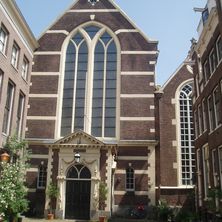

About twenty meters after crossing the busy Oude Hoogstraat you may notice a sign in black paint on a white wall behind a low wrought iron gate on the left hand side. It is in French and means "Church Wallonne, Protestant worship in French". This church is another example of Amsterdam tolerance; within its walls French-speaking protestants have been holding services from 1578 to this day.
The Walloon Church of Amsterdam dates back to 1409. Originally the building was the chapel of the St. Paul's Brotherhood Monastery, a lay monastery for ordinary citizens who wanted to lead a monastic existence. In 1452 a great fire destroyed the monastery and in 1493 the brotherhood received a permission to build a chapel which was dedicated three years later. The monastery then lay outside the city walls, but Amsterdam grew rapidly and by 1544 it was located well within the city.
From 1550 onward the thriving monastic life gradually waned, which undoubtedly had to do with the rise of Protestantism.
In 1578, Amsterdam, which had always maintained a status quo due to so many commercial interests at stake, became one of the last cities in the Northern Netherlands to succumb to the religious pressure. The Alteration was proclaimed and all Catholic churches and monasteries were expropriated. Much of the monastery grounds fell to the city, including the lot behind the church upon which the headquarters of the Dutch East India Company were later built. The chapel was transferred to the French-speaking Protestant refugees from the Southern Netherlands - present day southern Belgium - and northern France, and was named the WaalseKerk or EgliseWallonne. Religious reforms that Luther and Calvin deployed at the beginning of the sixteenth century and the subsequent religious persecution, led to the outbreak of the Eighty Years' War with the Spanish in 1568, and in 1588 to the founding of the Republic of the Seven United Netherlands. The refugees were being persecuted by the Spanish, who during the war occupied much of the Republic’s territory. The French-speaking refugees settled in Amsterdam, as the city was one of the few parts of the Republic that managed to avoid being controlled by the Spanish.
On August 24, 1572, during the infamous Bartolomeüs Night, nearly all the leaders of the Huguenots, as the French Calvinists called themselves, were murdered in France. This caused a great wave of refugees coming to the city and, after Antwerp fell to the Spanish in 1585, another great wave came. Fifteen Wallonian churches were established, mostly in major cities, between 1571 and 1590 alone. From the onset, during the National Synod held in Dordrecht in 1578, it was decided that Walloon Churches were to be part of the Dutch Reformed Church. In 1631 the parish of the Walloon Church bought three houses on Lauriestraat, where the Hospice Wallon, or the Walloons-Orphanage was established. The widows and the elderly also found shelter here.
The church was rebuilt in 1661 and expanded with a south aisle. In 20 years, the revocation of the Edict of Nantes led to another mass exodus of French-speaking Protestants, known as the Second Refuge. Under King Henri 4 the French Protestants were allowed a limited degree of freedom under the Edict of Nantes proclaimed in 1598. Henri 4 was assassinated in 1610 and in the course of the seventeenth century, the Huguenots, at the hands of the powerful Cardinal Richelieu and Louis 14, the "Sun King", suffered tighter and tighter restrictions on their rights. Louis 14 officially revoked the Edict of Nantes, which automatically outlawed those who openly professed the Protestant faith.
The exodus that followed was massive: two to three hundred thousand Huguenots fled to other countries in Europe and the Americas, primarily to the geographically close Netherlands. By 1688 the Republic had no less than 62 Walloon Churches, although some did not survive very long. Over the course of the eighteenth century the number of Walloon churches gradually decreased. Under the rule of King Louis Napoleon, Napoleon’s brother, the first installed by monarch in the Netherlands in the 19th century, their number was severely curtailed - French was then the national language, so a separate category of French-speaking churches in the eyes of the rulers was meaningless. Thereafter, under King William 1, their number decreased further, so that by 1817 there were only 21 left. Today there are only 14in the entire country. This decline is partly caused by the French-speaking Walloons gradually assimilating into the Dutch population and forgetting their language. During the last century most of the churches fell into further disuse. The increasing secularization, suffered by all the churches in the Netherlands, has also taken its toll.
Nevertheless, the Walloon community, though shrunk, lost none of its vitality. Weekly services are held here in French each Sunday at 11:00 AM. Thanks to its excellent acoustics and its no less exquisite organ, the Walloon Church is an excellent venue for organ lessons, concerts, CD recordings, and more recently - instead of harboring refugees - has become something of a haven to choirs and ensembles from all over the world.